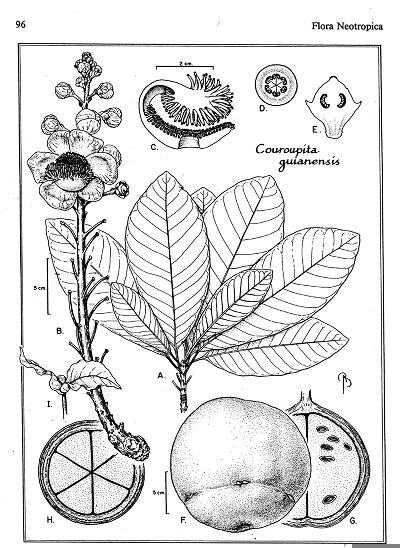Lecythidaceae
Couroupita guianensis Aubl.

Kingdom: Plantae Rank: Species Parent: Couroupita Status: Valid
Common Names:
- Ayahuma, bola de cañon - Spanish, Peru
- cannon ball tree - English, United States of America
Taxonomic Classification
Classification: There is considerable variation in the flower color of this species. The Los Amigos population has more yellow in the petals than do other populations, some of which have the entire adaxial petal surface red.
Morphological Description
Diagnosis: Tufts of trichomes in the axils of the secondary veins; conspicuous inflorescences arising from the trunk; showy aromatic flowers with the petals tinged with various degrees of yellow, pink, or red, a flat androecial hood, and a stamen-free area between the staminal ring and the hood staminodes; cannon-ball like fruits; and seeds embedded in a pulp that oxidizes bluish-green when exposed to the air.
Vegetative Morphology
Habit: Canopy trees, to 35 m tall. Trunks not buttressed. Bark smooth.
Leaves: Leaves with petioles 5-30 mm long; blades (6-)8-31(-57) x 3-10 cm, usually narrowly obovate to obovate, sometimes elliptic, glabrous adaxially, pubescent on veins abaxially, often with a tuft of trichomes (possibly domatia) in axils of secondary veins; base cuneate; margins entire; apex generally acute or acuminate; secondary veins in 15-25 pairs.
Reproductive Morphology
Inflorescence: Inflorescences cauline, usually unbranched racemes, sometimes weakly branched toward base, sometimes covering entire trunk; pedicels 12-60 mm long.
Flowers: Flowers 5-6 cm diam.; petals 6, flat at apices, variable in color, most commonly yellow toward apices and pink to red toward bases abaxially, pink to red except for white bases adaxially; androecium with stamen free area between staminal ring and hood, the hood white or pale yellow tinged with pink externally, the ring stamens with white filaments and pale yellow anthers, the hood staminodes often white at very base, pink for most of length, and yellow at apex, sometimes white for most of length and yellow at apex.
Fruit: Fruits 12-25 cm diam.
Other
Uses: Couroupita guianensis is widely planted in tropical and subtropical botanical gardens and as an occasional ornamental throughout the tropics and subtropics; it does well under cultivation as far north as the Fairchild Tropical Botanical Gardens in Florida.
Distribution: Panama, Amazonian Colombia, northern Venezuela, Guyana, Surinam, French Guiana, Amazonian Ecuador, Amazonian Peru, and eastern and southwestern Amazonian Brazil. This species has been collected in Costa Rica but these collections come from cultivated trees.
Ecology: I know of no ecological studies of C. guianenensis in which frequency, density, dominance, and habitat preferences have been reported. We have seen trees in lowland forests in non-flooded habitats and Poiteau (1825) reported that it grows in sandy soils along the coast of French Guiana.
Chromosome Number: x = 17
Notes: The flowers of C. guianensis are without nectar and are mostly visited by bees in search of pollen. Xylocopa brasilianorum has been reported to be the principal pollinator outside of the native range of C. guianensis in the botanical garden of the Museu Nacional in Rio de Janeiro (Ormund et al., 1981). Dahlgren (1924) states “The large black bumble-bees that visit the flowers force their way under the tip of the hood, between the two sets of stamens, and become thoroughly dusted with pollen.” It is likely that the bees observed by Dahlgren also represent a species of Xylocopa. Yarsick et al. (1986) report bees, wasps, and a flower fly visiting the flowers, but note that Xylocopa frontalis and a species of Bombus appear to be the most efficient pollinators. Prance and Mori (1979) report an observation made by H. W. Koepcke who studied a tree of this species over a three-week period. The ground under the tree was covered by many fruits which remained untouched until a herd of peccaries passed by and broke open the fruits and consumed the pulp. The seeds of species of Couroupita have exotestal trichomes which may protect them and facilitate their passage through the digestive tracts of animals (Tsou & Mori, 2002).
Typification
Type Citation: Hist. Pl. Guiane 2: 708, t. 282. 1775.
Basionym: Not applicable.
Basionym Citation: Not applicable.
Type Locality: French Guiana. Without specific locality.
Type Collection: Aublet s.n.
Types Deposited at: Holotype: Lectotype, BM; Isotypes: Isolectotype, S
Other Published Figures: Prance, G. T. 1990. Fl. Neotrop. Monogr. 21(II): figs. 34, 36 – habit, infl., fl, fr, seed.